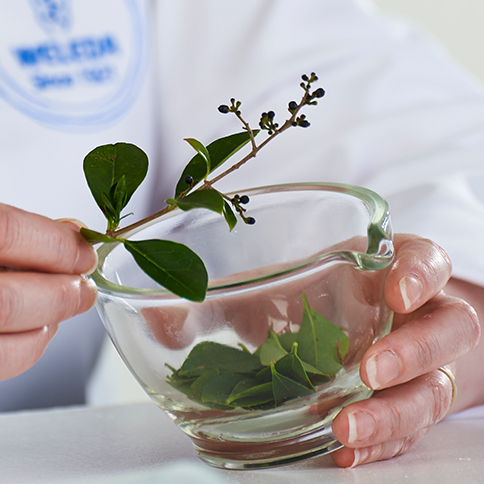
Magical day
I was thrilled to be invited by Permanent Publications to the Weleda Insight Day – an invitation made to all readers of Permaculture Magazine. It proved a day to surpass expectations. I hesitate to use ‘magical’ terms for fear of detracting from the factual base and deep-thinking that contributes to the biodynamic approach, but the garden was enchanting and the workshops spell-bounding.
Weleda’s UK operations are in Ilkeston, Derbyshire. HQ houses a full manufacturing department and an open-to-the-public shop, while their 13 acre biodynamically managed garden, ‘The Field’, is just a short distance away. This provides the plants that will become ingredients for many of Weleda’s natural medicines.
Natural skincare
As well as making herbal medicines, you may know Weleda as a skincare brand. We learnt during the day that a majority of their skincare products are created in mainland Europe (Weleda began in Switzerland in 1921 and is part of the Steiner movement of anthroposophy). As the UK garden focuses on making fresh plant tinctures one of the first surprises was the relatively small quantity of plants that are required to keep the manufacturing department supplied. Dismiss any visions you may have of acres of single-variety plants grown row-upon-row – Steiner believed mono crops grown under modern chemical based agricultural systems are ‘deaf to the universe’ – the gardens were compact, with each herb occupying perhaps a few square metres of space. They work at an allotment, rather than a farm, scale.
The garden tour
Gardeners Claire Hattersley and Felicity Pearce were our hosts for the day. It was a pleasure to be in their company – from a beaming welcome, through a carefully structured introduction to biodynamics and the Weleda approach, to their expert responses in the Q&A at the end of the day, their passion for the plants and the products shone through.

Touring the beds and polytunnel their conversation was peppered with facts and advice about the plants in their care – not just the remedies they were used for and the benefits they bring but also how they are nurtured. It became clear just how much thought and careful planning goes into the garden to ensure optimum growing conditions while keeping the right supplies flowing into manufacturing – despite the vagaries of the weather and the new challenges it sends each year. While very much present and listening to the plants growing around them now, they are also thinking four or five years ahead in their planning, propagation and rotation.
Adapting to climate change
As our climate changes, so too are their practices. No longer able to rely on the April outdoor calendula sowing to provide all their needs, they instead do successive sowing in modules that can be transplanted out in sequence – always working, of course, on a flower day for this crop.

Calendula is one of the plants grown in abundance on a field scale (as well as oats, hypericum and chamomile). The delicious-looking calendula patch is surrounded by a chicken wire fence a few feet high as a rabbit deterrent. This is put in place straight after planting, before any rabbits discover the plants – Felicity was confident that if the rabbits never taste the plant they don’t know what they’re missing; let them have one nibble and they’d be burrowing under the fence to get more! I did spot a rabbit during the visit, but not in the pristine calendula patch.
Compost
Our tour incorporated the composting field. Here the compost heaps are in pride of place, assuming the importance they deserve as the lifeblood of the garden. All plant waste material is carefully sorted into bays by type and size and then used to construct the prodigious mounds. A little cow manure is incorporated. We learnt in the afternoon workshops how important the cow is in biodynamic farming, and why. I certainly have a new appreciation for their silica-rich horns, and new perspective on our current ‘silicon age’ thanks to Claire’s explanation.
Meadow planting
Given the wash-out we’ve experienced this June our visit was truly blessed by sunshine making our pause in the meadow especially beautiful, with the backdrop of a massive rambling rose scenting the air. Seeing space given over for meadow planting – cowslips, plantain, greater burnet, red clover, yellow rattle, even orchids and more – alongside the productive planting that feeds the business, is just one of the indicators of the different approach taken by Weleda. With the species grown here they are able to actively support local wildlife trusts and organisations with seed saving and swapping to maintain and increase diversity on a much wider scale.

There was so much more in the tour than I have space to share now, whether your interest is seeds, bees, trees, herbs or compost teas you will be fascinated by a trip to the Weleda Field. And as an extra bonus, they magicked up a plant sale for us too. Having seen the care and attention that goes into raising these plants, and the sparkling specimens that were potted up, I don’t think anyone left without being tempted to take a friendly plant (or many) home with them.
Biodynamic growing
And that was just the morning! … A scrumptious lunch was provided by Mama Lou (all needs catered for) before we gathered round for an afternoon of workshops. The biodynamic methods used by Weleda were described with just enough tantalising detail to spark interest in my previously bemused mind. I had some awareness of biodynamic methods, but not real understanding. Claire’s explanation and hands-on demos and activities gently opened our eyes and hearts to this approach and certainly got me realising the sound basis for what at first seemed some pretty strange practices.
Herbal oils

Our day was completed with a tutorial in making our own herbal oils during which we all got to create a jar of healing calendula oil. This was added to a truly generous goody-bag enabling us each to take home and try products from across the Weleda range of skin food creams and balms, rose skincare, cleansers and bath and shower products plus a handmade seed bomb so we can scatter wild flowers.
Throughout our day we saw how the Weleda garden team work with the rhythms of the earth, responsive to its breathing. A day spent with them felt like true breathing space for us and certainly brought that connection and appreciation of what plants offer to us and how we and they can benefit by working in collaboration. In business Weleda have broken the mould, putting ecosystems before profit; as a skincare business I’d like to think they have provided a model that proves it is possible to work ethically and create beautiful products that benefit people and the planet.
I can thoroughly recommend taking the time to visit Weleda and am very grateful for the range of open days and workshops that they have made available. Set in wonderful surroundings, the days are planned with care, every practical detail attended to, and the vast knowledge of the team shared gently with humour, kindness and generosity.
The experience I’ve described here was a Weleda Insight Day, they also run Plant Study Days where you get to spend a whole day focusing on just one plant to really understand it – you can be sure I’ll be taking myself to Derbyshire to join one of those just as soon as I can.
To learn more about these, visit the Weleda website, and look under the ‘Field’ pages at opportunities to ‘Visit the Field’.


I have never been to any place like that but its indeed a place I wanna visit, a bit of curiosity in the herbals I definitely give it a try, how someone gets a pass or its invitation only?
It’s a great place to visit. You can book to go on one of their open days or workshops. Details are on the weleda website, look under the section about ‘the Field’ http://www.weleda.co.uk
Though I am seeing it late, Thankyou I would definitely gonna checkout!